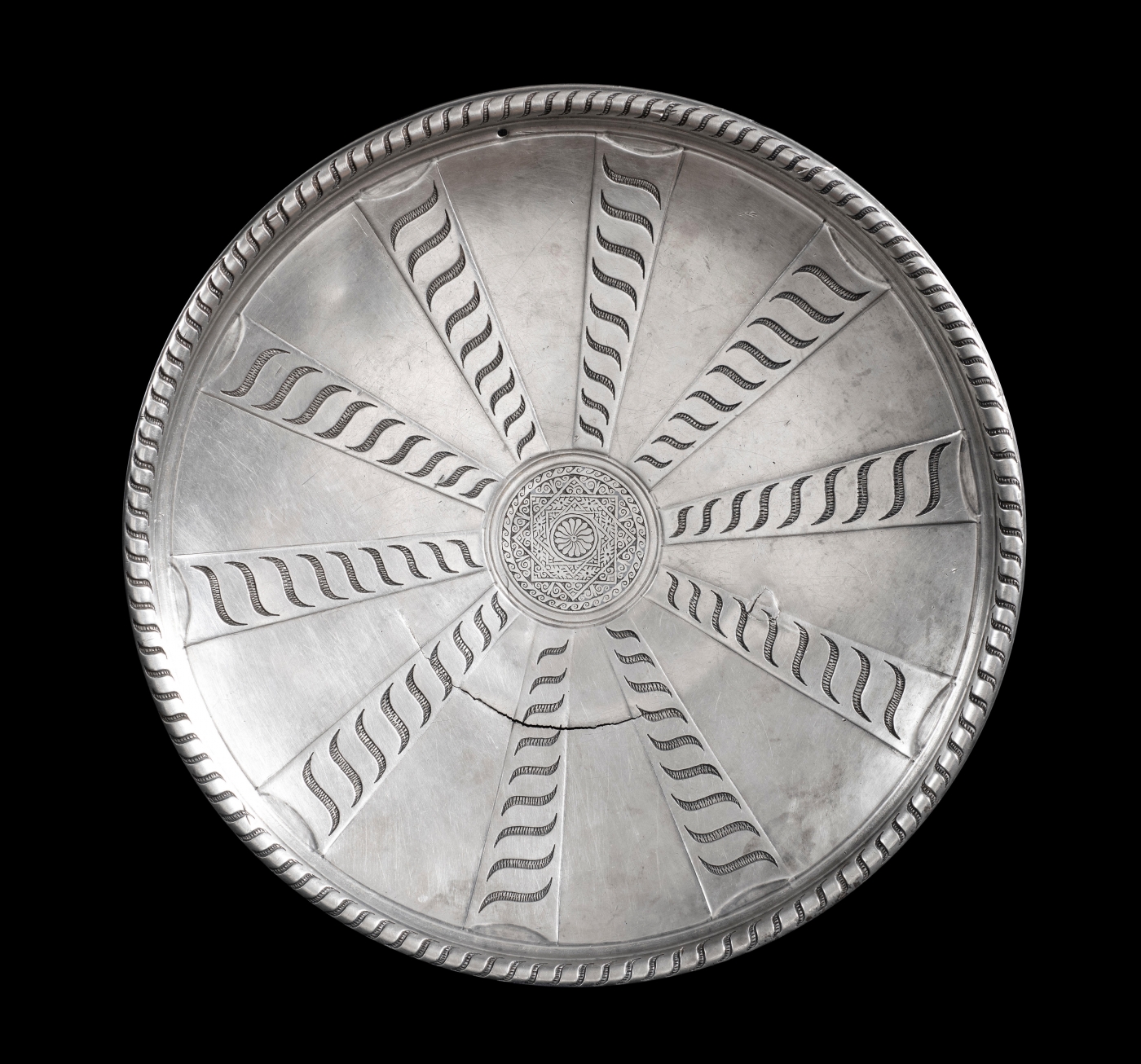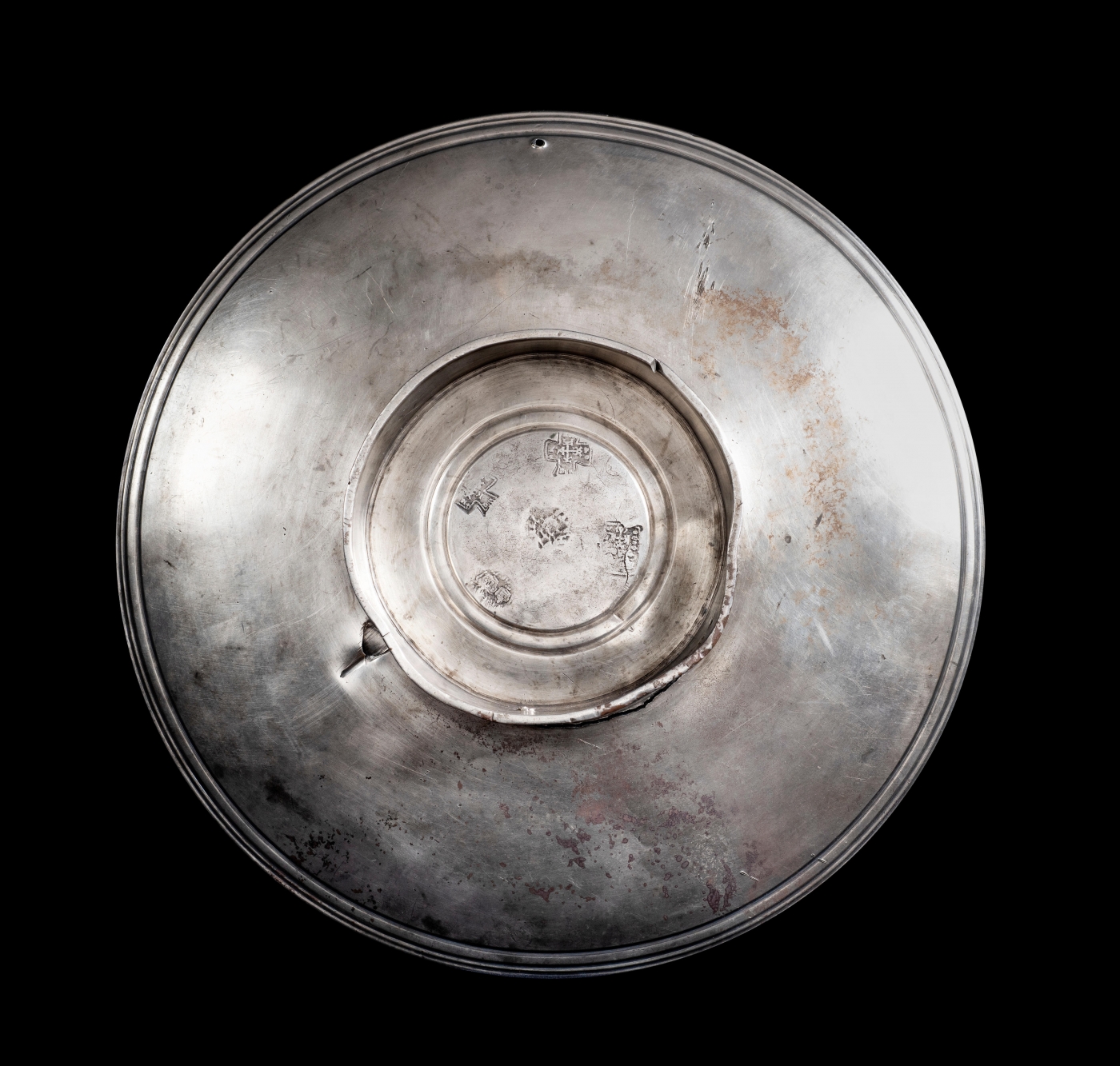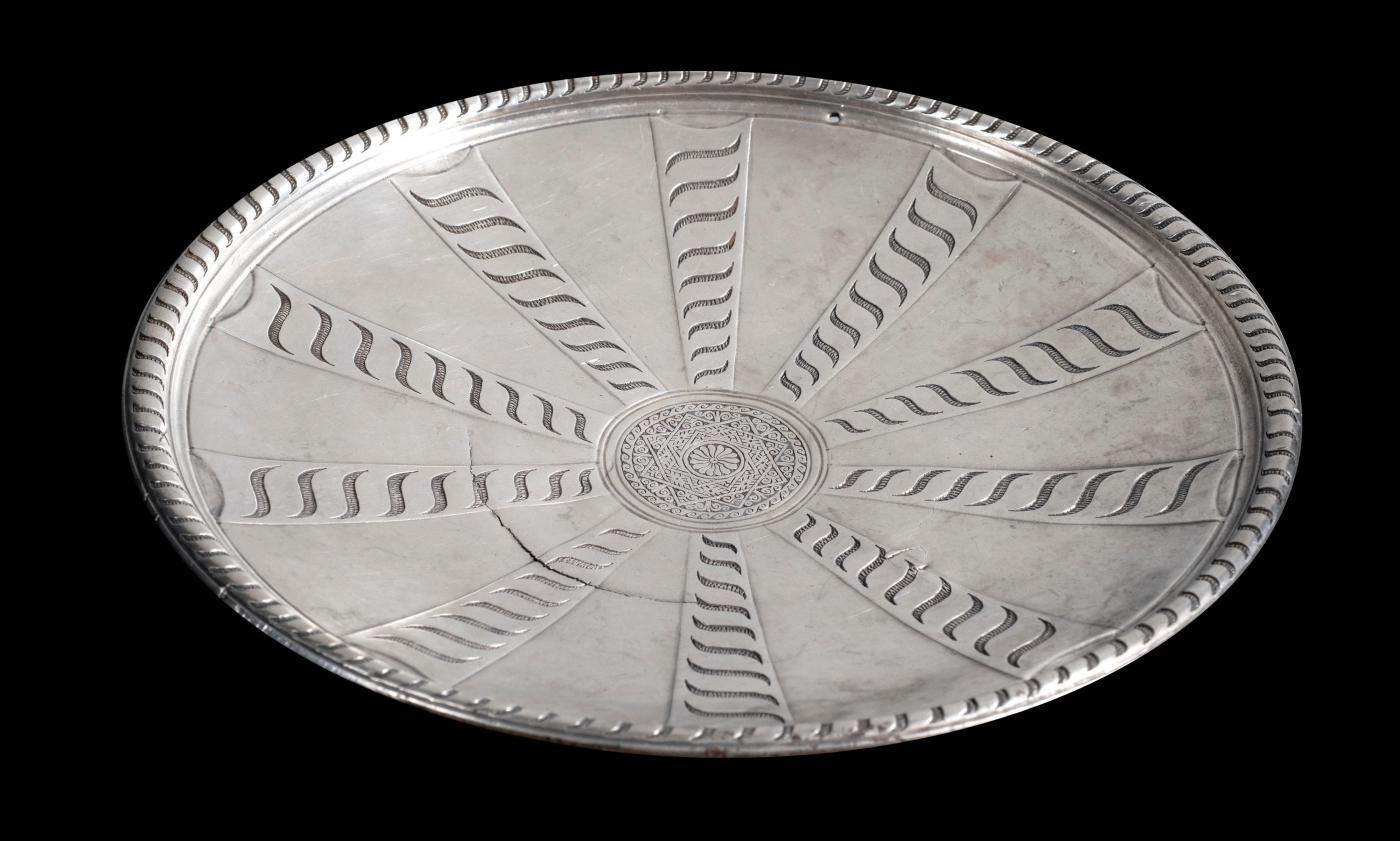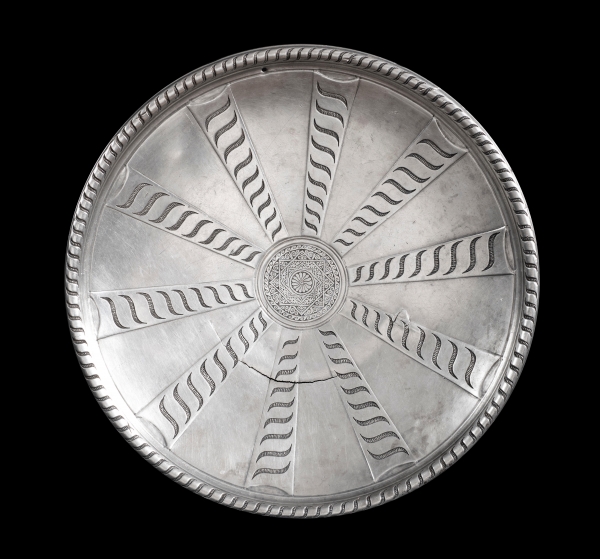Collection of Eleni Princess Cantacuzino (d. 1909), sent to London from Moscow in 1906 as a gift to her daughter Marie Princess Cantacuzino-Theophilou;
By descent, Collection of Athanase (d. 1963) and Maria (née Economopoulos) Sarmas;
By descent, Collection of Theodore Sarmas, London 1963-2003;
Sold to a European Private Collection, 2015;
Private Collection (Berlin) 2015-2023.
Click here to download the factsheet
The present plate is a superb example of the high-quality silver work of the early Byzantine period. The rim of the dish features a raised exterior border, decorated with a curved line motif that is echoed in the interior. Inside the dish, scalloped radials are adorned with lines, not brought to the edges of the raised panels, the ends of which curve in alternating directions. The latter motif creates a wave-like pattern that can be followed between the ribs, drawing the eye into the delicately rendered centerpiece. The central medallion is a series of concentric geometrics: two outer circles, the innermost of which features a Greek wave pattern, surround four intersecting squares, with the smaller squares naturally lying closer to the proper center. There, an exquisite rosette with fifteen leaves is inscribed. Luxury vessels in silver from this period vary widely in their decoration: many feature Christian religious scenes, and a smaller number pagan myths or bucolic landscapes. Geometric, non-figural examples such as this are relatively rare, though they display the highest level of workmanship. A very similar example from the same years, and perhaps even the same workshop, can be found in the Metropolitan Museum of Art in New York.
The underside of the plate, within the ring foot, features a set of five imperial control stamps. In the early Byzantine empire, silver was regulated by the state, as during this period it was rarer and thus more valuable than both bronze and gold. Beginning in the late 5th century, during the reign of Anastasius I (imp. AD 491-518), a system for endorsing silver released from the imperial treasury was devised. Standardized under Justinian I (imp. A.D. 527-565), the system of stamps featured five stamps, each of a different shape: round, long, square, hexagon, and cruciform. Typically, one stamp of each shape was placed onto silver vessels, most often before the dish was finished: visible damage to the seals incurred during the smithing process, paired with the fact that the undersides of these dishes do not bear evidence of hammering consistent with their repoussé interiors, have led scholars to believe that the interior and exterior were made separately, and the exterior was stamped, before being welded together.
The stamps on the underside of the present plate date it to the latter part of the reign of Constans II (imp. A.D. 641-668). In what remains of the round seal, which featured a portrait of the emperor, not only is Constans II himself depicted, but also his son and future successor Constanine IV (imp. 668-685), who was crowned co-emperor on Easter of A.D. 654, thus providing a strong terminus post quem of 654 for the creation of seals bearing this image. The round seal can be straightforwardly compared to portraits of the pair from coinage.
In addition to the round stamp, there are two cruciform stamps, one long stamp, and a central stamp that has sustained too much damage to be categorized (though it is most likely either square or hexagonal). Both cruciform stamps as well as the long stamp contain monograms—single characters that are made up of groups of Greek letters that can be rearranged into a proper name, in this case the name of the emperor. Here it is worth noting that Constans II shared a given name, and thus a monogram with his father Heraclius. Additionally, each of the arms of the crosses are inscribed with letters that can be arranged into names, though not in a uniform pattern across extant examples. These names, though largely illegible in our example, belonged to the officials whose office endorsed the imperial silver. At least one of these names was that of the comes sacrarum largitionem, or the “officer of imperial largesse,” who controlled imperial finances, including mints, coinage, and during this period the dispensation of imperial silver.
The presence of five stamps across silver dishes and ingots from this period indicates a specialized group of officials, of whom there were five at one time, though no list of such officers survives. Despite the lack of external evidence as to the identities of these officials, their importance is clear from the number of stamps that survive, as well as the longevity of the standardization system they oversaw (which was used from the late fifth century through the end of the reign of Constans II, nearly one hundred and fifty years). Scholars have pointed to apparent “irregularities” in the stamps from the reign of Constans II as evidence of the breaking down of the system of imperial control over silver that ended with his death: certainly, the present example is atypical, having as it does two cruciform seals. Despite this suggestion, however, it is clear from the excellent quality of this plate that Byzantine metal workshops were thriving at the time. The present silver plate with its stylized decoration ranks amongst the most elegant and attractive silver of the period, and it is indeed fortunate that it is also beautifully preserved.
References:
E. C. Dodd, Byzantine Silver Stamps: with an excursus on the Comes sacrarum largitionum by J. P. C. Kent.(Washington: the Dumbarton Oaks Research Library and Collection 1961).
Marvin C. Ross, Catalogue of the Byzantine and Early Medieval Antiquities in the Dumbarton Oaks Collection, Vol. I: Metalwork, Ceramics, Glass, Glyptics, Painting (Washington D.C. 1962), esp. p. 22-23 no. 17 and pl. xx.
Kurt Weitzmann (Ed.), Age of Spirituality: Late Antique and Early Christian Art, Third to Seventh Century (New York, The Metropolitan Museum of Art Exh. Cat. 1977).
Dagmar Stutzinger (Ed.), Spätantike und frünes Christentum (Frankfurt am Main, Liebieghaus Museum after Plastik Exh. Cat. 1983).
Marlia Mango, Silver from Early Byzantium. The Kaper Koraon and Related Treasures (Baltimore, The Walters Art Gallery Exh. Car. 1986).
Helen C. Evans and William D. Wixom (Eds.), The Glory of Byzantium. Art and Culture of the Middle Byzantine Era, A.D. 843-1261 (New York, The Metropolitan Museum of Art Exh. Cat. 1997).
William D. Wixom (Ed.) Mirror of the Medieval World (New York: The Metropolitan Museum of Art, 1999) no. 43, pp. 34–35.
Anastasia Lazaridou (Ed.), Transition to Christianity: Art of Late Antiquity, 3rd to 7th Century A.D. (New York, Onassis Foundation USA Exhibition Catalogue 2011).



